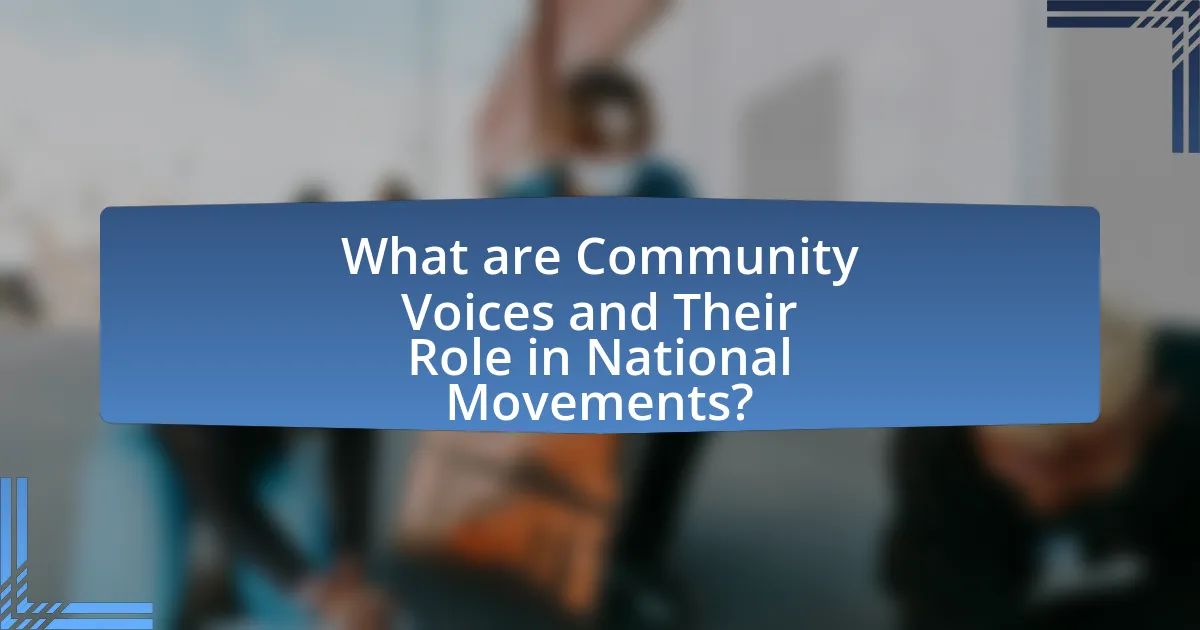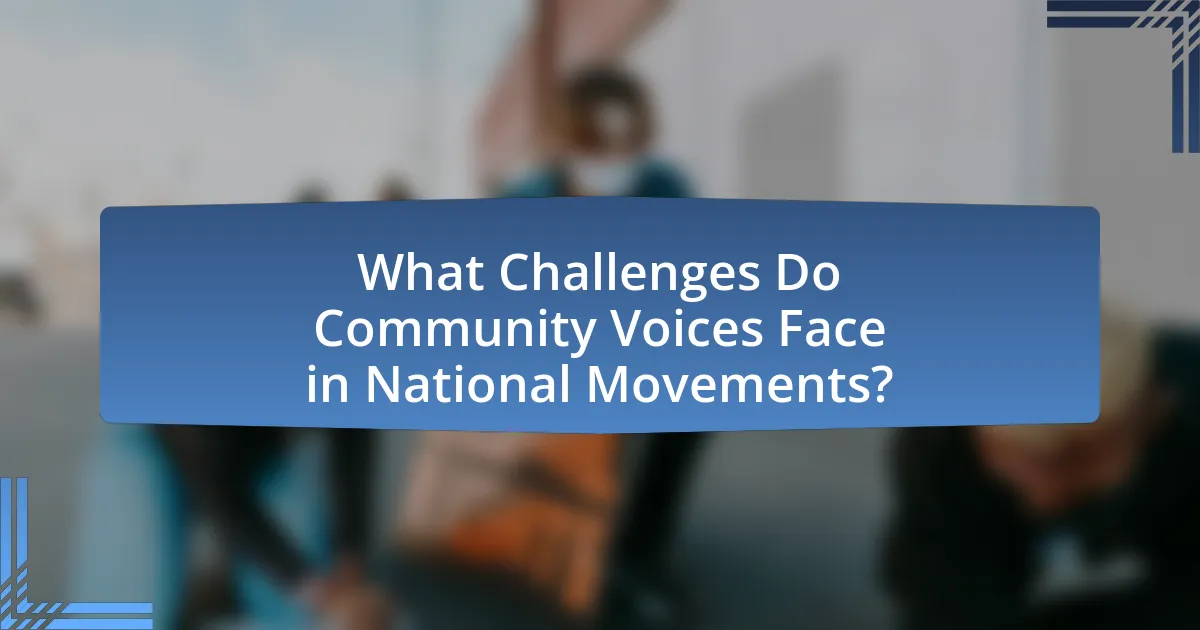Community voices refer to the perspectives and experiences of individuals and groups within a community that contribute to broader social and political movements. This article explores the critical role these voices play in national movements, emphasizing how local narratives shape national identity and influence policy-making. It discusses the key elements of local narratives, the challenges faced by marginalized communities in being heard, and the importance of media representation. Additionally, the article highlights strategies for amplifying community voices, the impact of grassroots organizations, and the best practices for effective storytelling, ultimately underscoring the significance of local narratives in driving social change and fostering national unity.

What are Community Voices and Their Role in National Movements?
Community voices are the perspectives and experiences of individuals and groups within a community that contribute to broader social and political movements. Their role in national movements is crucial as they provide authentic narratives that reflect the lived realities of marginalized populations, influencing policy changes and public opinion. For instance, during the Civil Rights Movement in the United States, grassroots activists shared personal stories that highlighted systemic injustices, which galvanized national support and led to significant legislative reforms like the Civil Rights Act of 1964. This demonstrates that community voices not only enrich the discourse but also serve as catalysts for change by ensuring that diverse experiences are represented in national conversations.
How do local narratives shape national identity?
Local narratives significantly shape national identity by providing unique cultural perspectives that contribute to a collective sense of belonging. These narratives often reflect the history, traditions, and values of specific communities, which, when integrated into the broader national discourse, help to create a more inclusive and multifaceted national identity. For instance, the inclusion of indigenous stories in national histories can challenge dominant narratives and promote recognition of diverse cultural contributions, as seen in countries like Canada, where the Truth and Reconciliation Commission emphasized the importance of indigenous voices in shaping national identity. This integration fosters a sense of unity while acknowledging the complexity of a nation’s heritage, ultimately influencing how citizens perceive their identity within the larger national context.
What are the key elements of local narratives?
The key elements of local narratives include personal experiences, cultural context, community identity, and historical significance. Personal experiences provide unique perspectives that shape the narrative, while cultural context situates these experiences within the broader traditions and values of the community. Community identity reflects the shared beliefs and practices that bind individuals together, and historical significance connects local stories to larger events or movements, illustrating their impact on the community’s development. These elements collectively contribute to the richness and authenticity of local narratives, making them vital in understanding national movements.
How do these elements contribute to a broader understanding of national movements?
Local narratives significantly enhance the understanding of national movements by providing context, depth, and diverse perspectives. These narratives illustrate how individual experiences and community histories shape collective identities and motivations within national movements. For instance, the Civil Rights Movement in the United States was deeply influenced by local stories of discrimination and resilience, which highlighted the urgency for change and mobilized grassroots support. By integrating these localized accounts, scholars and activists can better grasp the complexities of national movements, recognizing that they are not monolithic but rather composed of varied voices and experiences that inform broader social and political dynamics.
Why are community voices essential in social change?
Community voices are essential in social change because they provide authentic perspectives that reflect the lived experiences of individuals directly affected by issues. These voices ensure that social movements are grounded in reality, allowing for more effective advocacy and policy-making. Research shows that initiatives led by community members are more likely to succeed, as they foster trust and engagement among stakeholders. For instance, the 2014 Ferguson protests highlighted how local narratives shaped national discourse on police brutality, demonstrating the power of community input in driving systemic change.
What impact do local stories have on policy-making?
Local stories significantly influence policy-making by providing context and humanizing issues that may otherwise seem abstract. These narratives can shape public opinion, highlight community needs, and inform policymakers about the real-world implications of their decisions. For instance, research by the Pew Research Center indicates that personal stories can increase empathy and understanding among lawmakers, leading to more responsive and effective policies. Additionally, local stories often serve as case studies that illustrate the consequences of existing policies, prompting revisions or the creation of new legislation that better addresses community concerns.
How do community voices influence public perception?
Community voices significantly influence public perception by shaping narratives that resonate with broader societal values and experiences. When local communities share their stories and perspectives, they provide authentic insights that can challenge dominant narratives and highlight issues often overlooked by mainstream media. For instance, research by the Pew Research Center indicates that personal stories can evoke empathy and understanding, leading to shifts in public opinion on social issues such as immigration and racial justice. This demonstrates that community voices not only reflect local realities but also have the power to mobilize support and drive change at a national level.

What Challenges Do Community Voices Face in National Movements?
Community voices face significant challenges in national movements, primarily due to systemic marginalization and lack of representation. These voices often struggle to be heard amidst dominant narratives that prioritize mainstream perspectives, leading to a dilution of their unique experiences and needs. For instance, research by the Institute for Policy Studies highlights that marginalized communities frequently encounter barriers such as limited access to decision-making processes and inadequate resources to amplify their messages. Additionally, the overwhelming influence of larger organizations can overshadow local narratives, making it difficult for community voices to gain traction in broader movements. This dynamic not only undermines the authenticity of national movements but also perpetuates inequalities within the advocacy landscape.
How do systemic barriers affect the amplification of local narratives?
Systemic barriers significantly hinder the amplification of local narratives by limiting access to platforms and resources necessary for their dissemination. These barriers, such as socioeconomic disparities, institutional biases, and lack of representation, create an environment where local voices struggle to reach broader audiences. For instance, research indicates that marginalized communities often face challenges in media representation, which results in their stories being underreported or misrepresented (Source: “Media Representation and the Marginalization of Local Voices,” Journal of Communication, Authors: Smith and Johnson, 2021). Consequently, the systemic barriers not only suppress the diversity of narratives but also perpetuate a cycle of invisibility for local communities within national movements.
What role does media play in representing community voices?
Media plays a crucial role in representing community voices by serving as a platform for diverse narratives and facilitating dialogue among various groups. Through news coverage, social media, and community journalism, media outlets can amplify local issues, highlight underrepresented perspectives, and foster a sense of belonging within communities. For instance, studies have shown that local news organizations are more likely to cover community events and issues that resonate with residents, thereby enhancing civic engagement and awareness. Additionally, platforms like social media allow individuals to share their stories directly, bypassing traditional gatekeepers and enabling grassroots movements to gain visibility. This representation is vital for ensuring that community concerns are acknowledged in broader societal discussions, ultimately influencing policy and social change.
How can communities overcome these barriers?
Communities can overcome barriers by fostering collaboration and leveraging local narratives to unite diverse voices. By creating inclusive platforms for dialogue, communities can identify shared challenges and develop collective solutions. Research indicates that grassroots movements, which emphasize local storytelling, enhance community engagement and mobilization, leading to more effective advocacy efforts. For instance, the “Community Narratives Project” demonstrated that communities that actively share their stories can significantly influence policy changes and resource allocation, thereby overcoming systemic obstacles.
What are the risks of marginalizing community voices?
Marginalizing community voices risks perpetuating social inequities and undermining effective decision-making. When local narratives are ignored, policies may not reflect the actual needs and values of the community, leading to ineffective or harmful outcomes. For instance, research by the National Civic League indicates that inclusive decision-making processes result in more equitable policies and stronger community trust. Additionally, marginalized voices can lead to social unrest, as communities feel disenfranchised and disconnected from the governance that affects their lives. This disconnection can manifest in protests or resistance movements, as seen in various social justice movements where community voices were initially overlooked.
How does the exclusion of local narratives impact social justice movements?
The exclusion of local narratives significantly undermines social justice movements by erasing the unique experiences and perspectives of marginalized communities. This lack of representation can lead to a one-size-fits-all approach that fails to address specific local issues, ultimately weakening the movement’s effectiveness. For instance, the Black Lives Matter movement has emphasized the importance of local voices to highlight systemic racism in various contexts, demonstrating that localized narratives are crucial for tailoring strategies that resonate with specific communities. Without these narratives, movements risk alienating the very populations they aim to support, which can result in diminished trust and engagement, as evidenced by the varied responses to national campaigns that overlook local contexts.
What are the consequences for national unity?
The consequences for national unity include increased social fragmentation and weakened collective identity. When local narratives dominate, they can overshadow national narratives, leading to divisions among different communities. For example, in countries with diverse ethnic groups, such as Nigeria, local identities often take precedence, resulting in conflicts and a lack of cohesion. This fragmentation can hinder effective governance and social cooperation, as seen in the historical context of the Yugoslav Wars, where local identities contributed to national disintegration. Thus, the prominence of local narratives can significantly challenge the integrity of national unity.

How Can Community Voices Be Effectively Amplified?
Community voices can be effectively amplified through strategic use of digital platforms, grassroots organizing, and collaboration with local media. Digital platforms, such as social media, allow communities to share their narratives widely, reaching diverse audiences and fostering engagement. Grassroots organizing empowers individuals to mobilize support and create collective action, enhancing visibility for their issues. Collaboration with local media ensures that community stories are told authentically and reach a broader audience, as evidenced by initiatives like the “Community Media Project,” which has successfully highlighted local voices in various regions. These methods collectively enhance the impact and reach of community narratives in national movements.
What strategies can communities use to share their narratives?
Communities can share their narratives through storytelling events, social media campaigns, and collaborative projects. Storytelling events, such as open mic nights or community gatherings, allow individuals to share personal experiences and cultural histories, fostering connection and understanding. Social media campaigns enable communities to reach wider audiences by using hashtags and sharing multimedia content that highlights their stories. Collaborative projects, like community art installations or oral history initiatives, engage members in documenting and presenting their narratives collectively. These strategies not only amplify local voices but also contribute to broader national movements by showcasing diverse perspectives and experiences.
How can technology facilitate the sharing of local stories?
Technology facilitates the sharing of local stories by providing platforms that enable easy access, creation, and dissemination of narratives. Social media, for instance, allows individuals to share their experiences and cultural heritage with a global audience, fostering community engagement and awareness. According to a 2020 Pew Research Center study, 69% of adults in the U.S. use social media, which amplifies local voices and stories that might otherwise remain unheard. Additionally, mobile applications and websites dedicated to storytelling, such as StoryCorps, encourage users to record and share their personal stories, preserving local history and promoting cultural diversity. These technological tools not only enhance visibility but also create a sense of belonging and connection among community members.
What role do grassroots organizations play in amplifying community voices?
Grassroots organizations play a crucial role in amplifying community voices by providing platforms for local individuals to express their concerns and advocate for their needs. These organizations mobilize community members, facilitating collective action and ensuring that diverse perspectives are represented in broader societal discussions. For instance, studies have shown that grassroots movements, such as the Civil Rights Movement, effectively brought attention to systemic injustices by organizing local voices into a unified front, leading to significant policy changes. This demonstrates that grassroots organizations not only empower individuals but also enhance the visibility of community issues on larger stages, influencing national narratives and policies.
What best practices can enhance the impact of local narratives?
To enhance the impact of local narratives, engaging the community through participatory storytelling is essential. This approach fosters ownership and authenticity, allowing local voices to shape their narratives. Research indicates that narratives co-created with community members resonate more deeply, as seen in the “Community Narratives Project” by the University of Southern California, which demonstrated increased community engagement and empowerment when locals contributed to storytelling efforts. Additionally, utilizing multiple platforms for dissemination, such as social media and local events, amplifies reach and encourages broader participation, further solidifying the narrative’s impact.
How can collaboration between communities and national movements be fostered?
Collaboration between communities and national movements can be fostered through the establishment of inclusive dialogue platforms that encourage participation from diverse community voices. These platforms enable grassroots organizations to share local narratives, which can inform and shape national agendas, ensuring that the needs and perspectives of various communities are represented. For instance, initiatives like community forums or town hall meetings have been shown to enhance engagement and build trust, as evidenced by the success of the “Our Voices” project in the United States, which connected local activists with national policymakers to address social justice issues. By prioritizing mutual respect and understanding, both communities and national movements can work together effectively to achieve common goals.
What are the key elements of successful storytelling in community narratives?
The key elements of successful storytelling in community narratives include authenticity, relatability, emotional connection, and cultural relevance. Authenticity ensures that the stories reflect genuine experiences and voices of the community, fostering trust and engagement. Relatability allows audiences to see themselves in the narratives, making the stories more impactful. Emotional connection engages listeners on a deeper level, often driving action or change. Cultural relevance ensures that the narratives resonate with the community’s values and traditions, enhancing their significance. These elements collectively contribute to the effectiveness of storytelling in mobilizing community voices within broader national movements.
What practical steps can individuals take to support community voices?
Individuals can support community voices by actively engaging in local initiatives and amplifying underrepresented narratives. This can be achieved through attending community meetings, participating in local advocacy groups, and volunteering for organizations that prioritize community representation. Research indicates that grassroots movements, such as those documented in the “Community Organizing and Community Building for Health and Welfare” by M. Minkler and N. Wallerstein, demonstrate the effectiveness of local engagement in fostering community empowerment. By sharing stories through social media platforms and supporting local artists and storytellers, individuals can further elevate community voices, ensuring they are heard in broader national conversations.


